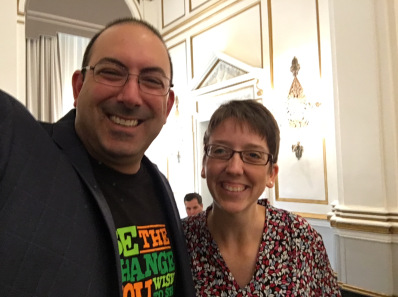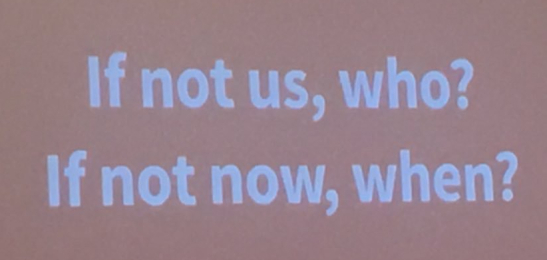Creating Transformative Schools
What a day. A full day of learning at #BLC18 and getting notice from @FETC (#FECT) about my involvement at the event. I also got to see Joy Kirr (@JoyKirr) speak and get even more energized for my work in creating transformative schools. And even got an “Usie” with her.

When that level of learning and excitement rush over someone, it is good to pause, soak it in, and reflect however you do that. For me the past year I have done that by writing down thoughts. That alone is a shift for me from “I worry if I make a mistake, or anyone will comment negatively, or….insert negative comment”. But for me, my shift is just doing it with the attitude of…If not now….when will I write

So, my reflections have been live on this blog and I have enjoyed the feedback and the confidence along the way to just “go for it” because it is how I like to process and reflect.
I also try to create a connective thread when I take in a lot of learning, and todays content coupled with my multiple sessions I will get to facilitate at FECT all seem to center around Creating Transformative Schools. One key session I am facilitating as a FETC featured speaker is “Blitz Transformation” so I wanted to dive into skills for that and to hone my session on Friday at #BLC18
Think about this question then you start your school transformative journey
“If we were going to start over, would we start the way we are doing it now?”
As a principal and district leader, I would say the above phrase whenever we evaluated a current program, revisit a long-standing decision, or when we are self-reflecting as an organization. If the answer to that question is “YES” then as a team we would work to enhance whatever the yes was referring to. However, if the answer is “NO” then we must pivot and begin planning and launching a new way.
Tech & Learning Newsletter
Tools and ideas to transform education. Sign up below.
Notice the word change was not used. Too often schools get caught up in “change” and never establish forward motion. A constant state of change is equivalent to standing still. As schools, we must evaluate our current stand and pivot to refocus goals and in turn launch something even more effective.
Tom Goodwin, an executive at the French media group, said “The world’s largest taxi firm, Uber, owns no cars. The world’s most popular media company, Facebook, creates no content. The world’s most valuable retailer, Alibaba, carries no stock. And the world’s largest accommodation provider, Airbnb, owns no property.”
These transformative companies did not “change” the travel or retail business, they evaluated what was already in existence, identified a need, didn’t just “do what we always did” but instead and worked to develop and efficient improvement by pivoting. I am sure Blockbuster Video wished it pivoted instead of holding its ground with video rentals. If they did, we may have never heard of Netflix. This type of transformational thinking directly relates to today’s schools.
How much have our classrooms changed since I graduated high school in 1989? Not in all cases, but desks are still in rows, teacher in the front of class, worksheets are frequently used, and the class supplies are paper, notebooks, pens and pencils. While many of these structures are still standard in many classrooms, many new instructional tools and methods have been designed. It’s now possible to access the almost limitless knowledge so shouldn’t does this shift the way we teach? If it hasn’t, then it is time to pivot to transform your district/school/classroom.
Increasingly education is about conformity, and you see is in the growth of mass produced text books and rise in standardized testing. The current paradigm is heavily influenced by the standardization influx, however we need to pivot the paradigm and go in the other direction.
Schools are experiencing a dramatic shift from how they’ve been run and structured for over a century. Leaders can establish direction, influence others, and initiate sustainable change as they navigate the ever-changing landscape of technology with the clear goal of improving student learning. Such leadership requires a dynamic combination of mindset, behaviors, and skills to enhance school culture through technology. A leader must have a vision to make a difference and the courage to pivot and make that vision a reality.
Think about the aforementioned forward-thinking companies and others like Google, Apple, and Amazon. Those companies pride themselves in a culture of providing flexibility, collaboration, team-based, project-based, and the capability of creating during the work day. School can be a place give classrooms and students creative opportunities and increase student participation, engagement, and retention. Giving students ownership in their own learning can make a more engaging classroom experience. This takes innovative leadership. We need innovative leaders to lead this charge and become like startup CEOs
This need for innovative school/district leadership comes from the rapid pace of educational change and the need to keep our learners engaged not focused on content distribution. The skills needed to teacher today change so fast and we need innovative leaders to lead this charge and become like startup CEOs Most importantly, the radical changes in our society mean that young learners need new kinds of skills, many of which are not even fully understood or codified for learning.
Real innovative leaders create an environment where new ideas can be tested and evaluated. A good CEO does not ask his creative team to make the “ONE” product and only take that one. He/she asks for prototypes and collaboratively takes be best part of 10 ideas to make the “next” idea. Also think of an artist’s studio where drafts and multiple drawings are completed before the final copy begins. So why not parallel that prototyping method with rapid adjustments and enhancements along the way in educational leadership? That creative feel is where real innovation and then in turn the deep learning happens.
Innovative leaders tend to be visionaries and motivate their followers through leading by example and fostering collaboration. Innovative leaders often have a strong vision that allows them to seize opportunities and recognize a “seedling” idea because their vision can see the flower. The most effective innovation leaders we have observed are those who can vividly describe their vision of the future, and can paint a clear picture of the destination, while we are developing the steps on how to get there. A few action steps I believe in and will share at #BLC18 in my session are:
Leading by Action
People follow people, not positions. They respect people who have accomplished something worthwhile and demonstrated that they deserve to be followed. In a paradigm shift, leaders need to modify practices and change mindsets. They can’t just talk about it; they must take action. The following leaderships skills can empower all students and educators to become leaders by their actions.
Action: Have Vision: Amidst all of the information, media sources, apps, and tools vying for our attention and dollars nowadays, it can be hard to focus and feel a sense of accomplishment. But vision gives us focus. Vision is a mental picture of the future that guides us, provides motivation to grow and improve, and gives us a sense of purpose. In leadership, vision helps us focus on the unchanging goal in the ever-changing K–12 education environment. Leaders prepare for the future of instruction by looking forward to see how students will best learn and retain information.
Pushback in change often comes from educators who ask, “Why do we need to teach like this? My students did well in the past, why change now?” Vision helps leaders communicate goals clearly and work on what is important to achieve the desired student success.
Action: Make a Difference: It’s often a teacher who provides that initial inspiration for a student to become a lifelong learner. Making a difference is not about what we do but about how we teach and act. By being both respectful and relevant, leaders inspire colleagues and students to become more confident and motivated critical thinkers and learners. In caring for students and collaborating with fellow staff members, leaders must be willing and able to use the most current and efficient learning tools to create an environment that is conducive for learning.
Critical thinking does not mean thinking harder before giving an answer. It means being critical of all possible answers. If students are asking more questions and feeling comfortable conducting research, you can rest assured that they’ll continue the habit outside your class. By demonstrating interest in their learning and providing the digital tools to assist them, leaders make a difference in the lives of students and their colleagues. That is action!
Action: Adding Value: Adding value is about opening doors to better opportunities for students or colleagues. Many leaders are too quick to take charge, but effective leaders listen (another leadership action) to understand those who will follow. A good leader listens to what every person believes is important and takes the needs of students and/or colleagues into account when choosing and sharing tools for learning and presenting knowledge.
Action: Take Risks: Everything that is worth doing involves risk. While it can be scary to try new things, once someone else jumps into a new idea or into the digital realm it’s a lot easier to follow. Dwight Carter said, “By taking risks and reflecting on the results, leaders create a culture of risk-taking in a school that affects both student and professional learning.” Successful leaders, guided by vision, are calculated risk takers. They’re willing to try something new, even if they fail. Instead of focusing on numbers and tasks accomplished, effective leaders reflect on the how and why as they assess, evaluate, and move vision into reality.
You got this
Schools are experiencing a dramatic shift from how they’ve been run and structured for over a century. Leaders can establish direction, influence others, and initiate sustainable change as they navigate the ever-changing landscape of technology with the clear goal of improving student learning. Such leadership requires a dynamic combination of mindset, behaviors, and skills to enhance school culture through technology. A leader can be anyone who has a vision to make a difference and the courage to make that vision a reality.
Dr. Matthew X. Joseph (@MatthewXJoseph) is currently Director of Digital Learning and Innovation for Milford Public School, Milford, Ma. Before Tech and Learning Boston 2018, he had the opportunity to present at #TLTechLive in Boston and New Jersey in 2017 and other state opportunities focused on Ed Tech Leadership and empowering teachers. Before Milford, he was a building principal for 11 years in Massachusetts. Other professional roles include: classroom teacher, PD specialist, and other district roles supporting technology instruction. Dr. Joseph holds licenses in general education, school administration, and MA superintendent. His master's degree is in SPED and he holds an Ed.D. in Educational Leadership from Boston College.
Dr. Matthew X. Joseph (@ MatthewXJoseph) is Director of Evaluation and Supervision in Brockton, MA.
